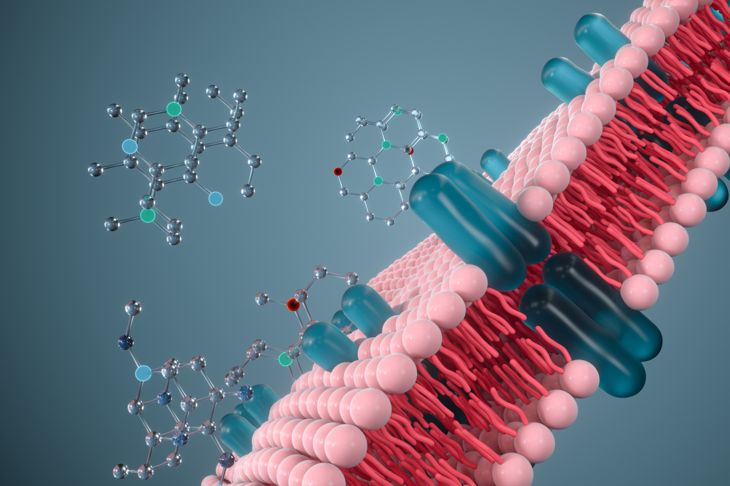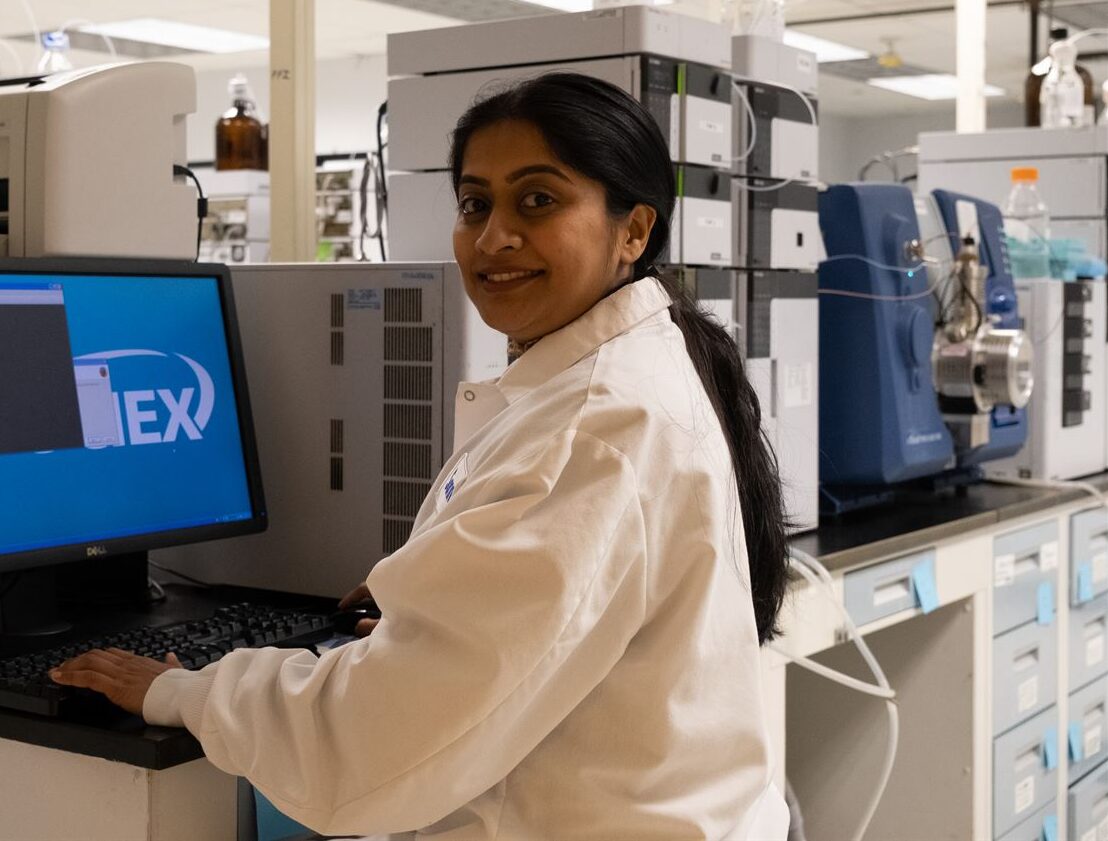Sannova
Objectives
- Understand lipids and their role as biomarkers
- Understand the importance of lipid analysis and its implications
- Identify the main challenges of lipid analysis via mass spec
- How Sannova can address mass spec challenges
The biochemical role of lipids
It is well established that lipids are hydrophobic or amphiphilic molecules which play a critical role in day-to-day biological functions1,2. Thus, identifying a lipid profile or composition can give insight to a series of biological cascades which can result from an external or internal stimuli3. Lipid levels in a tissue can reflect in either a potentially harmful or beneficial way4. Furthermore, being able to identify and quantify lipids is critical for understanding the impact a drug or cosmetic may have on a patient or consumer; this in turn can lead to safer and more efficacious products.

Lipids can be divided into several categories, including eicosanoids, fatty acids and sphingolipids to name a few. Eicosanoids have over 100 subtypes and are known to be key mediators in the inflammatory cascade5. Sphingolipids have been identified to have an important role in cellular death pathways as well as cancer cell survival and growth, depending on how they are biochemically activated6.
Furthermore, fatty acids are important in vascular function and immune response as they can be converted into eicosanoids and sphingolipids7,8. Since these lipids play a vital role in cellular and metabolic processes they are utilized as biomarkers to evaluate disease and therapeutic responses.
Lipids in formulations
In addition to their function as biomarkers, lipids have been used in wide range of cosmetic and pharmaceutical formulations as carriers or excipients. Lipid excipients are normally derived from vegetable oils and fatty acids8,10. In pharmaceutical formulations, lipids enable enhanced drug solubility and permeability, thereby increasing drug bioavailability11,12. This is partially due to lipids capabilities of activating physiological cascades, even if it is to a lesser degree. A recent review by Savla et al. found that 27 different drug molecules were FDA approved as 36 different oral drug products containing lipids. While some have been discontinued, it was due to the development of new formulations, not safety or efficacy issues11. Furthermore, one of the most recent advances in lipid technology includes their use as delivery vehicles for mRNA in both the Pfizer-BioNTech and Moderna COVID-19 vaccines.
In cosmetics, lipids are major component especially for products that are intended to be applied to skin. These cosmetic emulsions are usually designed to protect and hydrate skin. Fatty acids and sphingolipids are frequently used in topical cosmetics since they are the main lipid component in the skin’s epidermal layer8. It is not surprising that deficiency in these classes of lipids can lead to skin inflammation and irritation considering their biochemical roles.
It is evident that lipids play in important role, not only as biomarkers, but both in drug and personal care product formulations. There are thousands of lipids and identifying the correct lipid for a specific application requires a strong understanding of their structure, function and the matrix being studied. For example, a small change in a lipid’s molecular structure, such as the change in position of a double bond, can influence the physicochemical properties. In addition, certain lipid to protein interactions are specific to isomeric structures13. This phenomenon is evident in the arachidonic acid (AA) pathway, which plays a key role in tissue inflammation. AA can be metabolized by prostaglandins produced by cyclooxygenases (COXs), which have two isoforms, COX-1 and COX-2. COX-1 is the main source of basal level prostaglandins, whereas COX-2 can be activated by various inflammatory stimuli. Aspirin and non-steroidal anti-inflammatory drugs (NSAIDs) reduce inflammation by inhibiting COX-2, however, this can lead to cardiovascular side effects14. Therefore, it is important to consider the biochemical response a lipid will mediate whether it is applied topically or ingested. While the process of incorporating lipids into formulations can be time consuming and costly11, analytical methods which are continuously providing new insight into lipids and their biochemical cascade.
MS industry standard
Multiple analytical methods for lipid analysis have been developed, including, gas chromatography (GC), liquid chromatography (LC), enzyme-linked immunosorbent assays (ELISA), nuclear magnetic resonance (NMR), and mass spectrometry (MS)15. However, the current industry standard for lipid analysis uses an orthogonal approach by combing two analytical methods. LC is typically coupled with tandem MS (LC-MS/MS), due to its relative low cost and high sensitivity2,3,16. LC-MS/MS is a powerful tool due to the quantitative and qualitative data it provides. For example, tandem MS provides a combination of high-resolution mass analysis and collision-induced dissociation (CID) which has allowed for the identification of 300 lipids in one sample17.
The first step for analysis is using an organic solvent to extract lipids from complex matrices such as skin tapes, blood and urine. Lipid extraction from skin tapes can be more intensive as it requires a homogenization step. Extraction is followed by LC which separates the lipids based on their physiochemical properties, specifically their polar head-group classes, carbon-chain length, and the number of double bonds18. This is proceeded by detection and analysis via tandem MS18. A key advantage of using chromatographic based MS is the reduction in interference from lipids present in high concentrations. This separation of lipids allows for the less abundant lipids to be identified and more accurately quantified16. This approach can be further categorized into targeted and un-targeted (unbiased) analysis. In un-targeted analysis a wide range of lipid classes are analyzed whereas in targeted analysis, a specific class of lipid is analyzed. Targeted analysis can result in method development with high sensitivity for quantitative analysis15.
Main challenges of MS lipid analysis
The greatest challenge with lipid analysis is distinguishing them due to isotopes which exist in nature. For example, many eicosanoids are isobaric with very similar physiochemical properties19. While standard MS techniques cannot identify them all, there are approaches that can be invoked to yield stronger results2. This includes utilizing different solvents and changing the pH, using multiple internal standards and varying ion source polarity2. The most common extraction method uses methanol, chloroform and water; however, it is typically modified as needed by the addition of salts, acids and bases15. In addition, the ionization step and addition of internal standards are processes that should be carefully considered.
The development of ionization technology is a leading reason MS has become a standard for lipid analysis with electron and chemical ionization being the most widely used methods15. The ionization step is critical due to the affect it can have on fragment distribution which is important for interpretation of the structural data. Lipid fragmentation is highly dependent on its class which makes it difficult to have a standardized process. In addition, lipids in general may not fragment well which can lead to confounding results20. This issue is also a contributor to the importance of using internal standards.
The appropriate way of utilizing an internal standard is to ensure it is similar to the compound being quantified, but not found in the sample. Deuterium-labeled lipid analogs of the compound are usually used however, similar lipid class odd-carbon chain molecular species can also be used21. While these are common troubleshooting steps for lipid analysis, it is still a difficult task. However, there are scientists that have been proficient at tackling these types of problems, including scientists at Sannova.
Sannova’s expertise in lipid analysis
Although there are thousands of lipid species, many of them only differ by the number of fatty acyl carbons, number of double bonds, double bond positions, as well as differences in functional groups20. This makes it difficult to accurately identify them even if the equipment for analysis is readily available. Being able to distinguish lipids requires a strong background in analytical chemistry and physiology. Which is why it is important to be utilize the resources that are readily available, such as a CRO that specializes in analytical methods. Sannova is well equipped to take on method development and validation for lipid analysis.
For example, Sannova has been able to successfully identify lipids from complex matrices such as skin, blood and urine. This includes 11 dehydrothromboxane-B2, and 2,3-dinor-6-keto-PGF1α in human urine, as well as thromboxane B2 in plasma. In addition, Sannova has also run isotopically labeled straight chain fatty acids from C-14 to C-30 in various matrices.
Summary
To summarize, lipids influence a wide array of biological functions which are dictated by their structural properties. Their versatility has made them notable for use as biomarkers and applications in formulations for the pharmaceutical and cosmetic industries. Due to their isomeric properties, techniques to distinguish have continued to rapidly evolve, particularly MS. The application of MS techniques has been instrumental in discovering and understanding lipids and their abundant species. LC-MS/MS has become the industry standard for lipid analysis since it is it is high throughput and has a high sensitivity. MS techniques can be modified based on the lipid class that is being analyzed, however, the successful use of MS requires a strong understanding of chemistry and biology. Sannova has the equipment and experts required that can reduce the time and cost of developing and validating methods for MS analysis.

References
- Hu, T. & Zhang, J. L. Mass-spectrometry-based lipidomics. J Sep Sci 41, 351-372, doi:10.1002/jssc.201700709 (2018).
- Uphoff, A. H., M. ; Haimi, P.; & Somerhaarju, P. Analysis of complex lipidomes.
Hu, C., Li, J. & Xu, G. in General Methods in Biomarker Research and their Applications Biomarkers in Disease: Methods, Discoveries and Applications Ch. Chapter 36, 49-74 (2015). - Mantel-Teeuwisse, A. K. & Drug-Induced Lipid Changes A Review of the Unintended Effects of Some Commonly Used Drugs on Serum Lipid Levels. (2001).
- Dennis, E. A. & Norris, P. C. Eicosanoid storm in infection and inflammation. Nat Rev Immunol 15, 511-523, doi:10.1038/nri3859 (2015).
- Gulbins, E. Book Sphingolipids in Disease. (2013).
- Quehenberger, O. et al. Lipidomics reveals a remarkable diversity of lipids in human plasma. J Lipid Res 51, 3299-3305, doi:10.1194/jlr.M009449 (2010).
- Ahmad, A. & Ahsan, H. Lipid-based formulations in cosmeceuticals and biopharmaceuticals. Biomedical Dermatology 4, doi:10.1186/s41702-020-00062-9 (2020).
- Wymann, M. P. & Schneiter, R. Lipid signalling in disease. Nat Rev Mol Cell Biol 9, 162-176, doi:10.1038/nrm2335 (2008).
- Siepmann, J. et al. Lipids and polymers in pharmaceutical technology: Lifelong companions. Int J Pharm 558, 128-142, doi:10.1016/j.ijpharm.2018.12.080 (2019).
- Savla, R., Browne, J., Plassat, V., Wasan, K. M. & Wasan, E. K. Review and analysis of FDA approved drugs using lipid-based formulations. Drug Dev Ind Pharm 43, 1743-1758, doi:10.1080/03639045.2017.1342654 (2017).
- Porter, C. J., Trevaskis, N. L. & Charman, W. N. Lipids and lipid-based formulations: optimizing the oral delivery of lipophilic drugs. Nat Rev Drug Discov 6, 231-248, doi:10.1038/nrd2197 (2007).
- Claes, B. S. R. et al. Mass Spectrometry Imaging of Lipids with Isomer Resolution Using High-Pressure Ozone-Induced Dissociation. Anal Chem 93, 9826-9834, doi:10.1021/acs.analchem.1c01377 (2021).
- Wang, B. et al. Metabolism pathways of arachidonic acids: mechanisms and potential therapeutic targets. Signal Transduct Target Ther 6, 94, doi:10.1038/s41392-020-00443-w (2021).
- Li, L. et al. Mass spectrometry methodology in lipid analysis. Int J Mol Sci 15, 10492-10507, doi:10.3390/ijms150610492 (2014).
- Yang, K. & Han, X. Accurate quantification of lipid species by electrospray ionization mass spectrometry – Meet a key challenge in lipidomics. Metabolites 1, 21-40, doi:10.3390/metabo1010021 (2011).
- Batarseh, A. M. A., S.K. ; Duchoslav, E. ; Alqarni, A. ; Blanksby, S.J. Discrimination of isobaric and isomeric lipids in complex mixture. International Journal of Mass Spectrometry, 27-36 (2018).
- Ding, M. & Rexrode, K. M. A Review of Lipidomics of Cardiovascular Disease Highlights the Importance of Isolating Lipoproteins. Metabolites 10, doi:10.3390/metabo10040163 (2020).
- Chhonker, Y. S. et al. Simultaneous Quantitation of Lipid Biomarkers for Inflammatory Bowel Disease Using LC-MS/MS. Metabolites 11, doi:10.3390/metabo11020106 (2021).
- Murphy, R. C. & Gaskell, S. J. New applications of mass spectrometry in lipid analysis. J Biol Chem 286, 25427-25433, doi:10.1074/jbc.R111.233478 (2011).
- Harkewicz, R. & Dennis, E. A. Applications of mass spectrometry to lipids and membranes. Annu Rev Biochem 80, 301-325, doi:10.1146/annurev-biochem-060409-092612 (2011).
Speak to one of our scientists to learn more
